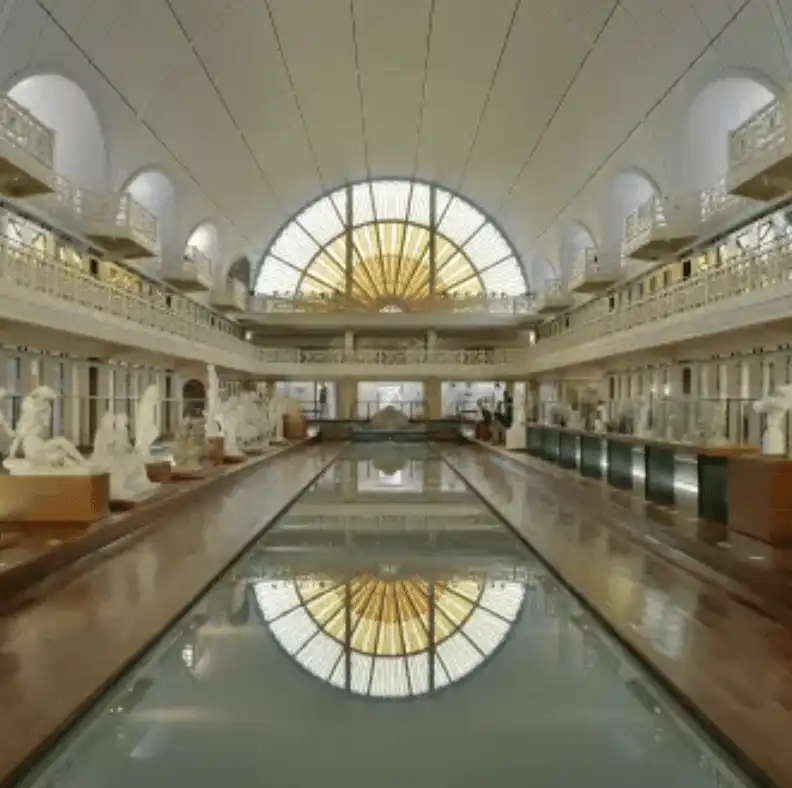Forget Versailles: one of Paris’s best day trips Is a little-known northern gem.

Set aside the grandeur of Versailles for a moment, and turn your attention to a hidden gem in the north of France, the unassuming former industrial city of Roubaix. While it may not be a city that typically beckons tourists, it boasts one of the most splendid residences and a museum of unparalleled beauty, making it one of the most rewarding day trips you can take from Paris.
The city, sometimes described as “the city of a thousand chimneys,” was once a powerhouse in the global wool industry but has since faded into relative obscurity, overshadowed by the fame of its native son, Bernard Arnault, Europe’s wealthiest man. Nevertheless, Roubaix holds the key to an exceptional day out, offering a glimpse into the opulent Villa Cavrois and the enchanting La Piscine museum, all without the overwhelming crowds that inundate other tourist destinations near the French capital.
A mere hour-long high-speed train ride from Paris to Lille, followed by a short taxi journey to Roubaix, transports you to a world that feels like a different country, especially on the damp early spring mornings that characterize this region. Located just a stone’s throw from Belgium, Roubaix is perpetually shrouded in moisture. The taxi ride to Villa Cavrois, followed by a return to the city and a visit to La Piscine, takes you through an architectural tapestry that bears witness to centuries of territorial disputes. Amid the classical French limestone structures, you’ll find streets lined with brick townhouses adorned with striking white accents, reminiscent of England or the Netherlands.
As you explore the city, you’ll encounter remnants of its storied past, such as the elaborate gatehouse of the Palais Vaissier on Rue de Mouvaux, a now-demolished Orientalist palace built during the Belle Epoque by a soap magnate. Exiting the city center and approaching Villa Cavrois, you’ll meander along a boulevard flanked by charming Anglo-Norman mansions.
The story of Villa Cavrois begins with Paul and Lucie Cavrois, textile magnates who, in 1923, commissioned Jacques Gréber to design a fairy-tale manor perched on a hill in the commune of Croix. However, just two years into the project, inspired by the revolutionary Exposition Internationale des Arts Décoratifs of 1925 that coined the term “Art Deco,” the Cavrois family enlisted the services of architect Robert Mallet-Stevens. The stunning transformation was underway, led by one of the era’s prominent architects.
Villa Cavrois, a 20,000-square-foot marvel, stands as a testament to modernist design. Its austere facade, adorned with golden yellow brick – an unusual choice associated more with factories or municipal buildings – stands in stark contrast to the historicist homes that once surrounded it. Mallet-Stevens’ deliberate emphasis on the color and horizontality of the building is accentuated by the pitch-black horizontal mortar joints and vertical yellow dye.
Mallet-Stevens, an accomplished set designer of the silent film era, conceived Villa Cavrois as a modern stage where domestic life unfolds. The villa’s grandeur lies in its colors, materials, and meticulous details, which captivate the discerning eye. The living room, with its towering glass wall overlooking the lawn, is adorned with lichen green and features a sunken black-and-yellow Siena marble fireplace. The dining rooms exude elegance, with green Swedish marble, zebrawood, and artistic details. Chrome accents abound throughout the house, from radiator covers to cabinets, adding a touch of modernity to the interiors. The master bedroom, wrapped in palm veneer, and the master bathroom, resplendent in sleek white marble, exemplify the epitome of luxury.
Thanks to extensive efforts by the French government, many original furnishings adorn the house, preserving its authentic ambiance. The tour takes visitors back in time, allowing them to appreciate the precision and opulence of Mallet-Stevens’ vision.
The Villa Cavrois wasn’t the only architectural treasure Roubaix held. A former swimming complex in the city center, originally commissioned by Jean-Baptiste Lebas, a socialist mayor and hygiene advocate, was transformed into an exquisite museum, La Piscine. The complex, with its Art Deco details, had served the public as a luxurious bathhouse. Still, it ultimately required a new lease on life, resulting in its remarkable metamorphosis into a museum of exceptional beauty.
The revival of this aquatic masterpiece was spearheaded by Jean-Paul Philippon, an architect who had previously transformed the former Orsay train station in Paris into a renowned art museum. The newly refurbished La Piscine now houses an impressive array of artworks, as well as a section dedicated to the history of Roubaix, providing visitors with valuable context about the city.
The cathedral-like pool area at La Piscine offers a mesmerizing experience, with its colorful glass and ceramic tiles reflecting in the water. The museum’s sculpture collection is artfully displayed on pontoons within the pool, creating a striking tableau. The pool area itself is a visual masterpiece, with an elegant portico designed by Alexandre Sandier at one end.
While there are certainly more iconic and bustling day trips from Paris, such as Versailles or Giverny, Roubaix’s Villa Cavrois and La Piscine offer a unique and enriching experience, free from the tourist hordes. This old factory town, with its captivating architectural gems and artistic treasures, invites you to explore a lesser-known facet of French heritage and creativity.
Villa Cavrois is open daily except Mondays, from 10 a.m. to 6 p.m. La Piscine is open from Tuesday to Thursday from 11 a.m. to 6 p.m., Fridays from 11 a.m. to 8 p.m., and on weekends from 1 p.m. to 6 p.m. The museum is closed on Mondays.
Source: https://themessenger.com
Contact Paris Property Group to learn more about buying or selling property in Paris.


Social Cookies
Social Cookies are used to enable you to share pages and content you find interesting throughout the website through third-party social networking or other websites (including, potentially for advertising purposes related to social networking).